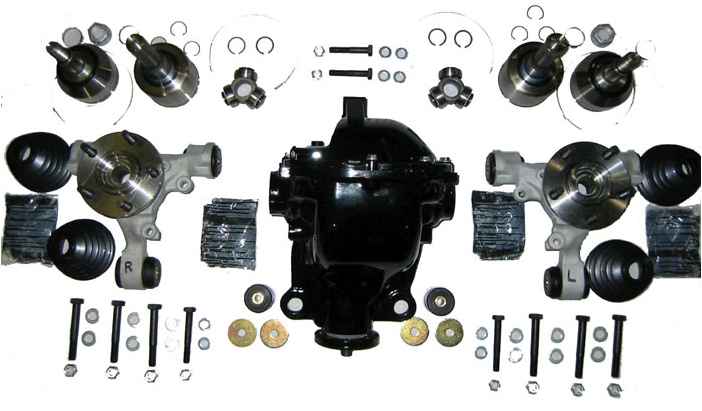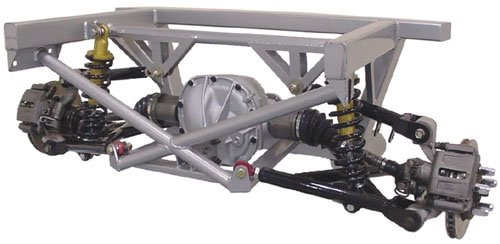There are four possible rear suspension configurations for the FFR Roadster:
A solid axle design refers to the fact that the entire wheel-axle-differential assembly is suspended from the chassis with struts, shocks, and springs. In contrast, an independent rear design suspends each wheel-axle separately, leaving the center differential fixed to the chassis.
4-link solid axle
Part of the donor car concept heritage, chassis mounts provide for a simple bolt on of Ford Mustang quad shocks and the standard 8.8” posi-traction differential with the variable rate Mustang coil springs. This is an inexpensive and reasonable choice when mated to a mild 200 hp engine from the donor.
While aftermarket upgrades exist for this configuration, the geometry is non-optimal for high performance engines over 300 hp due to oversteer issues, and the additional cost of enhancements make this unpractical for our non-donor build.
3-link solid axle
Evolved from Challenge Car race experience, the 3-link is now the standard Mk3.1 and Mk4 Complete Kit rear configuration and includes the frame brackets, panhard rod that spans across the wheel base, control arms, Koni coil-over shocks and aftermarket springs.
For drag racing, this is probably the best Roadster suspension. However, a street version will experience more bounce and less control in curves and rough road surfaces than an independent suspension would in similar conditions.
Until the introduction of a comprehensive non-donor IRS solution, the 3-link represented an excellent suspension alternative, and remains a good choice for a lower cost build.
5-link solid axle
A premium solid axle solution is provided by Levy Racing in the form of a Watts 5-link design that dispenses with the long panhard rod. This configuration is engineered for high performance racing, especially competitive drag strips. However, the multi-link system is complex, more expensive than 3- or 4-link (and nearly the same cost as IRS), requires welding, and careful performance “tuning” adjustment, so it is not the best choice for a street Roadster with a mid-range engine (300 to 400 HP).
Independent suspension

Until the introduction of the Mk3.1 Complete Kit, independent rear suspension (IRS) was at the “bleeding edge” of Roadster evolution requiring essentially a separate donor vehicle — a 1989-1997 Ford Thunderbird — to harvest the 8.8″ center section as well as a handful of special parts.
After a year of development in 1998, the FFR “beta version” IRS was tested in 1999 during the NE Replica Challenge races. That success led to early adopter IRS builds, but the process was complex and expensive for several more years.
Fortunately today, IRS is a cost-effective and well-engineered option for the Complete Kit. FFR modifies the chassis at the factory with a welded-in IRS cage.
A donor is no longer required since the differential, brakes, custom tubular control arms (upper and lower), Koni coil-over shocks (same as the front shocks), special-sized axles, and CV joints/boots are included in the Complete Kit. Seals-it Rod End seals from Breeze improve the bearing action.
Without question, the IRS is the most authentic replication of the original AC Cobra road feel.
IRS is the choice for this build.
IRS overview

The Mk3 independent rear suspension (IRS) is bolted to a cage welded to the main chassis. Like the independent front suspension (IFS), the IRS upper and lower control arms (UCA and LCA) fasten to the chassis cage to support the knuckle (like the IFS spindle) and hub assembly that, in turn, holds the rear disk brake system.
At the center of the cage sits the center differential (sometimes referred to as the pumpkin due to its round shape) connected to the knuckles via short half-shaft rear axles. The differential-to-axle link is made through a constant velocity joint (CV) protected by a rubber boot. Coil-over-shocks are set up in a configuration similar to the IFS. The front facing of the differential connects to the transmission via a spline driveshaft to complete the drivetrain setup, while the knuckles holds 5-lug hubs that attach to the wheels.
Power is therefore transmitted to the wheels by the following connected components:
– engine/transmission → 28 spline driveshaft
– driveshaft → Eaton Truetrac geared limited slip differential with 3.55:1 gears
– differential → CV/axle covered by rubber boot
– axle → knuckle supported by UCA and LCA with coil-over-shock assembly
– knuckle → 5-lug hub
– hub → wheel/tire